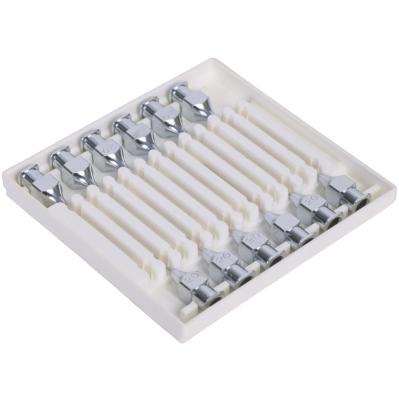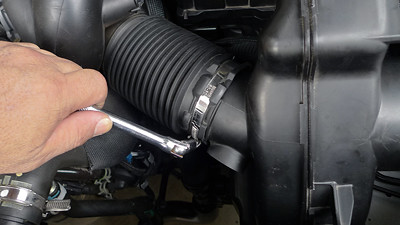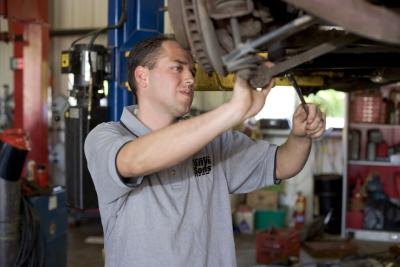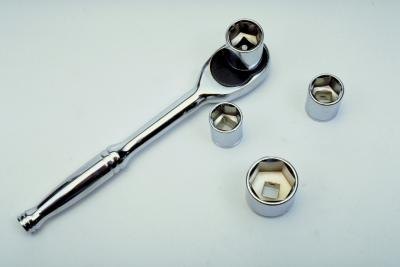
The 2001 Dodge Ram 2500 is the 3/4-ton version of the Dodge Ram 1500 (1/2-ton). It was also available in a 1-ton version. This truck always featured front disc brakes which used brake pads. While it was more common for this truck to feature rear drum brakes, it was also available with rear disc brakes. Disc brakes integrate brake calipers, brake rotors and brake pads. When the brake pedal is depressed, the caliper pistons press the pads against the surface of the rotors to slow and stop the vehicle.
Instructions
- 1
Park your Ram 2500 on a level surface substantial enough for lifting and supporting a 3/4-ton truck. Apply the parking brake if youre replacing the front brake pads but do not apply the parking brake if youre replacing the rear brake pads.
2Place a wheel block against the outside tread of a tire on the opposite axle that youre replacing the brake pads on then loosen the lug nuts on the two wheels of the same axle youre replacing the brake pads on using a lug nut wrench. Do not loosen the nuts more than half a turn.
3Lift the axle youre replacing the brake pads on with a 3/4-ton rated jack and support the axle on two 3/4-ton rated jack stands placed under each front lower control arm or under each side of the rear axle, respectively.
4Remove the lug nuts then the tires.
5Place a pry bar into the caliper pad window against the steel plate of the outboard pad and pry the pad against the rotor until the caliper piston compresses enough to loosen the brake pads and caliper.
6Remove the upper and lower caliper bolts using a ratchet and a 3/8-inch hex-head socket bit, then remove the caliper from the rotor and knuckle assembly. Rest the caliper on a milk crate or sturdy box so there is no tension on the brake hose attached to the caliper.
7Use the pry bar to unseat one of the outboard pad retaining springs from the caliper housing then pull the remaining spring of the pad off of the caliper.
8Place a caliper piston reset clamp or a large C-clamp onto the face of the inboard pad and the housing of the caliper and tighten the clamp to fully compress the caliper piston into the caliper.
9Remove the clamp then unseat the inboard caliper brake pad retaining clip from the hollow caliper piston. Use the pry bar if necessary.
10Use a wire brush to scrub off the rust, brake dust and other debris on the sliding surfaces of the caliper and the knuckle, then apply a coat of the silicone brake grease onto the respective surfaces.
11Insert the inboard pad and retaining clip into the hollow caliper piston, making sure the steel plate of the pad is flush against the piston. Set one side of the outboard pads retaining spring onto the outer caliper housing then pivot the pad onto the housing to clip the remaining retaining spring.
12Place the caliper and pad assembly onto the rotor and knuckle assembly and hand-thread the caliper bolts into the caliper. Tighten the bolts with the ratchet and 3/8-inch hex-head socket bit. Repeat the brake pad replacement procedure for the other wheel.
13Replace the tires and lug nuts. Tighten the nuts with the lug nut wrench, applying a star formation until the nuts hold the tires firmly onto the wheel hubs.
14Lower the Ram to the ground then tighten the lug nuts, applying the star pattern with the torque wrench set at 135 foot-pounds and a socket.
15Apply the brake pedal several times until it feels firm then check the brake fluid level in the master cylinder. Add brake fluid if necessary. Remove the wheel block, disengage the parking brake (if applicable) then test-drive the truck.
 Before getting the car back on road, first thing to do is to renew insurance & road tax and do some minor maintenance.
Before getting the car back on road, first thing to do is to renew insurance & road tax and do some minor maintenance. .... yes indeed, I need 19mm bolt caps. Now my 308 uses 19mm instead of std 17mm wheel bolts.
.... yes indeed, I need 19mm bolt caps. Now my 308 uses 19mm instead of std 17mm wheel bolts.






 The oil filter cartridge housing can be removed with 27mm socket wrench. Oil drain plug needs 8mm allen key (not shown).
The oil filter cartridge housing can be removed with 27mm socket wrench. Oil drain plug needs 8mm allen key (not shown).
 Thanks God! Apart from the word "PEUGEOT" and the lion emblems there is only one sweet and simple looking badge, "308".
Thanks God! Apart from the word "PEUGEOT" and the lion emblems there is only one sweet and simple looking badge, "308".



 Fortunately there are several ways to protect ourselves from
Fortunately there are several ways to protect ourselves from  Avoid a costly
Avoid a costly 
















